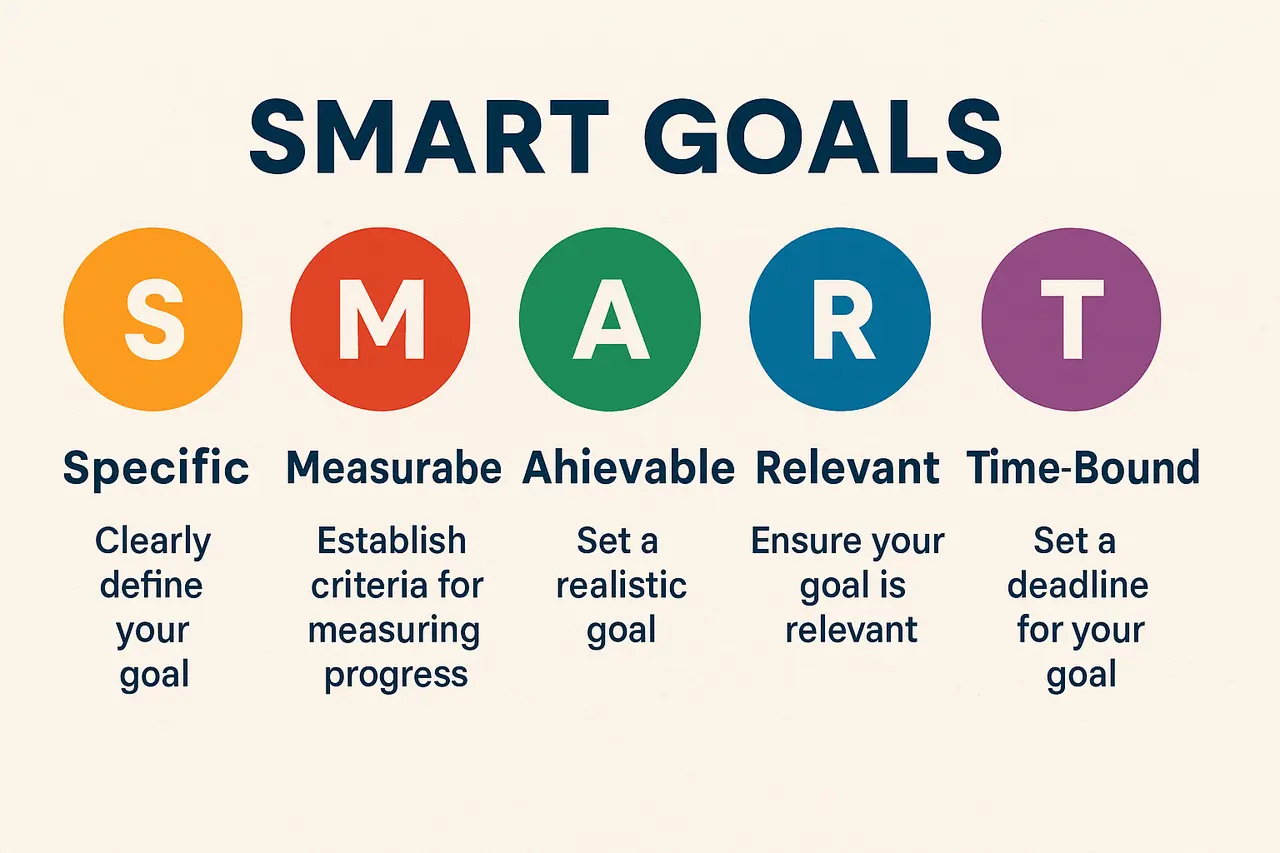How to Set Goals and Achieve Them: A Practical Step-by-Step Guide

Learning how to set goals and achieve them requires more than wishful thinking. Research shows effective goal setting combines five core elements: specificity, measurability, difficulty, proximity, and commitment.
Studies confirm that people who write down SMART goals (Specific, Measurable, Actionable, Rewarding, Time-specific) achieve 42% higher success rates than those who don’t.
Neuroscience reveals that goals direct attention, energize effort, increase persistence, and trigger strategy development through four proven mechanisms.
Combining challenging short-term goals with long-term objectives produces superior results compared to vague “do your best” intentions.
Implementation requires tracking progress, building accountability systems, and adjusting strategies based on feedback to transform aspirations into measurable outcomes..
Why Goal Setting Matters
Without goals, you drift.
You wake up, go through the motions, and repeat. But everything changes when you set a specific goal that matters to you. You move with purpose.
Goals give your life structure. They:
And here’s the kicker: setting realistic, measurable goals makes you far more likely to achieve them. You make effective goal setting one of the most powerful tools for change.
So if your goal is to become stronger, smarter, or more stable, this guide shows you the steps you need to take to achieve that goal.
10 tips to set goals and achieve them
Step 1: Know What You Want
To achieve a goal, you need to start with clarity.
Most people set goals they don’t even want. They set goals that sound good. Goals that impress people. But none of that lasts.
So slow down and ask:
This is your foundation. Every goal must come from a place of real desire.
Values Drive Motivation
The goals you set should be built around what matters to you.
If your values are freedom, connection, and creativity, then goals that relate to those values will feel motivating.
But if you ignore that, you’ll burn out chasing goals that don’t fit.
Goals that make you come alive are the ones worth pursuing.

Step 2: Use the SMART Framework To Set Goals
You need to make your goal clear, measurable, and realistic. That’s smart goal setting at its core.
That’s where the SMART framework comes in:
SMART goals keep you focused. Without that structure, your goals aren’t goals. They’re wishes.
Vague: I want to save money.
SMART: I’ll save $500 in 10 weeks by transferring $50 from each paycheck.
See the difference?
Knowing how to set goals the right way makes the process smoother and helps you avoid wasting time.
Create goals with a specific outcome, and set a deadline to accomplish the goal.

Step 3: Break It Down Into Smaller Goals
Big goals fail when they’re not broken down.
Your brain can’t process giant, vague ideas like “launch a business” or “lose 50 pounds.”
But when you break your goal into smaller goals and daily steps, it starts to feel doable.
Pick one goal. Break it into key milestones. Then break each milestone into tasks.
If your goal is to write a book:
When you break it down, you set yourself up for success. This approach helps you understand exactly what you need to do to achieve your goal and removes the mental clutter.
Step 4: Write Your Goals Down
This step is non-negotiable.
People who write down their goals are more likely to achieve these goals than those who don’t.
Use a journal, app, or spreadsheet. Just don’t keep it in your head.
When you write your goals, they become real. You can see them, track them, and adjust them.
Tools That Help You Achieve Your Goals
| Tool | Best For | Why It Works |
|---|---|---|
| Trello | Task tracking | Drag-to-Done boosts motivation |
| Notion | All-in-one hub | Links tasks, habits, notes |
| Strides | Habit streaks | Visual chains encourage consistency |
| Google Calendar | Time blocking | Converts tasks into appointments |
Each tool puts your plan where you see it and can help you achieve your goals by surfacing gaps early.
Step 5: Build Momentum With One Smart Goal at a Time
Don’t set five new goals at once. That’s how people burn out.
Pick your first goal. Focus all your energy there. Make progress. Then move on.
Too many people get stuck because they’re chasing too many goals and finishing none.
Focus builds success. One goal, done well, creates momentum. This kind of goal achievement fuels long-term progress.
Step 6: Expect Obstacles and Stay Adaptable
Every big goal comes with friction. You will get tired. You will face doubt.
That doesn’t mean your goal is wrong. It just means you’re human.
Instead of quitting, adapt.
Revisit your timeline. Adjust your tactics. Stay honest about what’s working and what’s not.
This flexible approach to goal setting gives you room to grow. If you need to adjust your goal, do it with intention, not guilt.

Step 7: Set Daily Habits That Support Your Personal Goals
Your goal is the destination. Your habits are the vehicle.
If your goal is to practice mindfulness, you need to:
Habits create the structure that helps you accomplish a goal, especially long-term goals that require consistency.
Want to see progress? Set daily actions that lead somewhere. Most people skip this step, but it’s a key part of effective goal setting that keeps your progress steady and intentional.
Step 8: Stay Motivated With Meaning
Motivation fades. Discipline carries you through.
But when your goal is motivating, it still helps to remember why you started.
When you want to quit, ask:
This reflection keeps your focus alive.
Reward yourself when you hit milestones. It strengthens your commitment and keeps your goals meaningful and easy to focus on.
Step 9: Review, Adjust, and Set New Goals
You’re not done when you reach your goal. You’re done when the process becomes part of you.
Review what worked. What didn’t? Set a new goal that excites you.
Review your goals regularly. Weekly or monthly check-ins help you stay honest and flexible.
Some goals may no longer matter. Let them go.
And some goals that require more time? Keep going. Not all progress is fast.
The best way to set and achieve your goals is to stay in the game long enough to figure out what works. Goal setting is a process, not a one-time event.
Subscribe to Create Higher Vibrations!
Get Inspiration and Practical advice straight to your inbox.
Step 10: Know the Different Types of Goals
Not all goals are created equal. There are short-term goals, long-term goals, and everything in between.
No matter if you’re setting personal goals or professional goals, define exactly what success means to you, what it looks like, feels like, and how you’ll know you’ve reached it.
You’re setting personal goals? Make sure they reflect who you are. You’re setting professional goals? Tie them to growth and measurable outcomes.
Whatever types of goals you’re aiming for, they must reflect your priorities. Goals you’ll commit to are the ones that create change.
Achieve Your Goal
When you try to set and achieve goals, most people overcomplicate it.
Here’s what works:
Whether you’re setting short-term goals or going after a big goal that will take years, this approach will help you get there.
Knowing how to set goals, track them, and stick with them over time will help you achieve your goals, no matter how ambitious.
Set yourself up for success. Use an approach to goal setting that works.
Make sure your goal has a purpose. Then do the work to reach it.
Goals that make you think, stretch, and grow are worth your time.
When you follow these strategies for success, you’ll accomplish more than you thought possible.
Set goals that matter. Goals that push you. Goals that change things.
Then do the work. You’ll get there.
Frequently Asked Questions
Why is goal setting important?
+Setting goals provides direction and purpose in life. Instead of just going through the motions, having specific goals helps clarify your next steps, focus your energy, boost confidence as you reach milestones, and ultimately makes you more likely to achieve what you want. Effective goal setting is a powerful tool for creating change in your life.
How do I figure out what goals I should set?
+The crucial first step is to gain clarity on what you genuinely want, rather than setting goals that sound good or impress others. Ask yourself: What do I truly want? What kind of life goal would make a significant difference for me? What goals align with my core values? Goals that resonate with your values will be more motivating and sustainable.
What is the SMART framework for goal setting?
+The SMART framework is a method for creating clear, measurable, and realistic goals. SMART stands for:
- Specific: Clearly define what you want to accomplish.
- Measurable: Determine how you will track your progress.
- Achievable: Ensure the goal is realistic given your resources and time.
- Relevant: Confirm the goal aligns with your overall life vision.
- Time-bound: Set a specific deadline for when the goal should be completed.
Using the SMART framework transforms vague wishes into actionable plans.
Why is it important to break down large goals?
+Large, ambitious goals can feel overwhelming and difficult to tackle. Breaking them down into smaller, manageable milestones and then into daily or weekly tasks makes the goal feel more achievable. This process helps you understand exactly what steps are needed and reduces mental clutter, setting you up for success.
Should I write down my goals?
+Yes, writing down your goals is considered non-negotiable for effective goal setting. Studies show that people who write down their goals are more likely to achieve them. Writing goals makes them tangible, allows you to track progress, and makes it easier to adjust your plan as needed.
How can I maintain momentum when working towards a goal?
+Focus is key to building momentum. Instead of attempting to work on multiple new goals simultaneously, choose one key goal to focus on first. Direct all your energy towards making progress on that single goal. Completing one goal well creates momentum and fuels long-term progress, preventing burnout from spreading your efforts too thin.
What role do daily habits play in achieving goals?
+Daily habits are the foundation for reaching your goals. Think of your goal as the destination and your habits as the vehicle that gets you there. Establishing consistent daily actions that support your goal, such as scheduling specific time or tracking your progress, creates the necessary structure for steady and intentional progress, especially for long-term goals.
How do I stay motivated and handle obstacles?
+While motivation can fluctuate, discipline is crucial for sustained effort. To stay motivated, connect your goals to meaning by reflecting on the pain of quitting versus the benefits of continuing. Expect obstacles and be adaptable; challenges don’t mean your goal is wrong, just that you may need to adjust your timeline or tactics with intention. Rewarding yourself for hitting milestones can also strengthen commitment and keep your goal meaningful.


